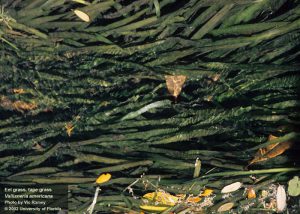Article by Gadsden County Extension Agent
DJ Zadarreyal
Vallisneria americana, also known as tape grass or eel grass, is a common native aquatic weed in the state of Florida. Tape grass has tall, grass-like leaves that are a light green in coloration and rise vertically from the crown to the top of the water. Once the leaves reach the top of the water, they casually float along the surface.
The technique of propagation is by runners. These runners grow out from the crown along the sand and new plants arise from the end of them. There are separate male and female plants, although they grow on the same plant. The female flowers are on lengthy stems, which reach to the surface. However, the male flowers are loosely attached at the base of the leaves. When released, the male flowers float to the surface where they move alongside the female flowers to fertilize them.
A good way to distinguish tape grass from other weeds is to observe the leaves and the tips. Tape grass have round leaf tips while many other weeds have pointed leaf tips. In addition, tape grass is a submerged weed that possesses long, ribbon like leaves.
There are several uses for tape grass. Restoration of the pond floor is a useful purpose. One of the benefits of tape grass is that they are great oxygenators. Tape grass is also a common home based aquarium plant. They provide an eye-catching scene that fish and humans enjoy.
Source:
Guide of Tropical Fish, Everything You Need to Know About Tropical Fish
- St. Joe Red Tide Claiming Terrapins - December 15, 2025
- The 2025 Snake Watch Report for the Pensacola Bay Area - December 15, 2025
- Rattlesnakes on Our Barrier Islands; Part 2 – Prey Selection - December 15, 2025

